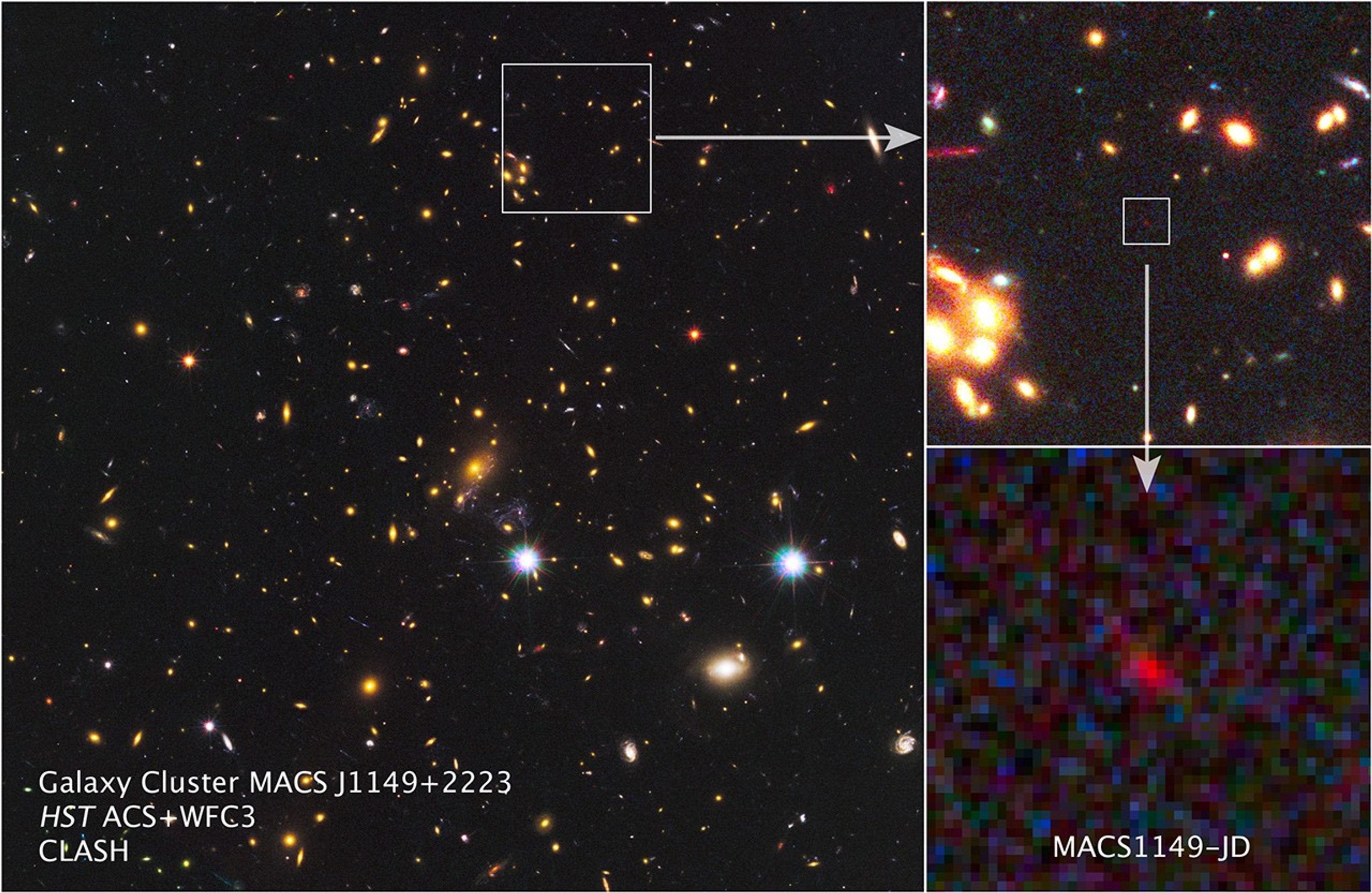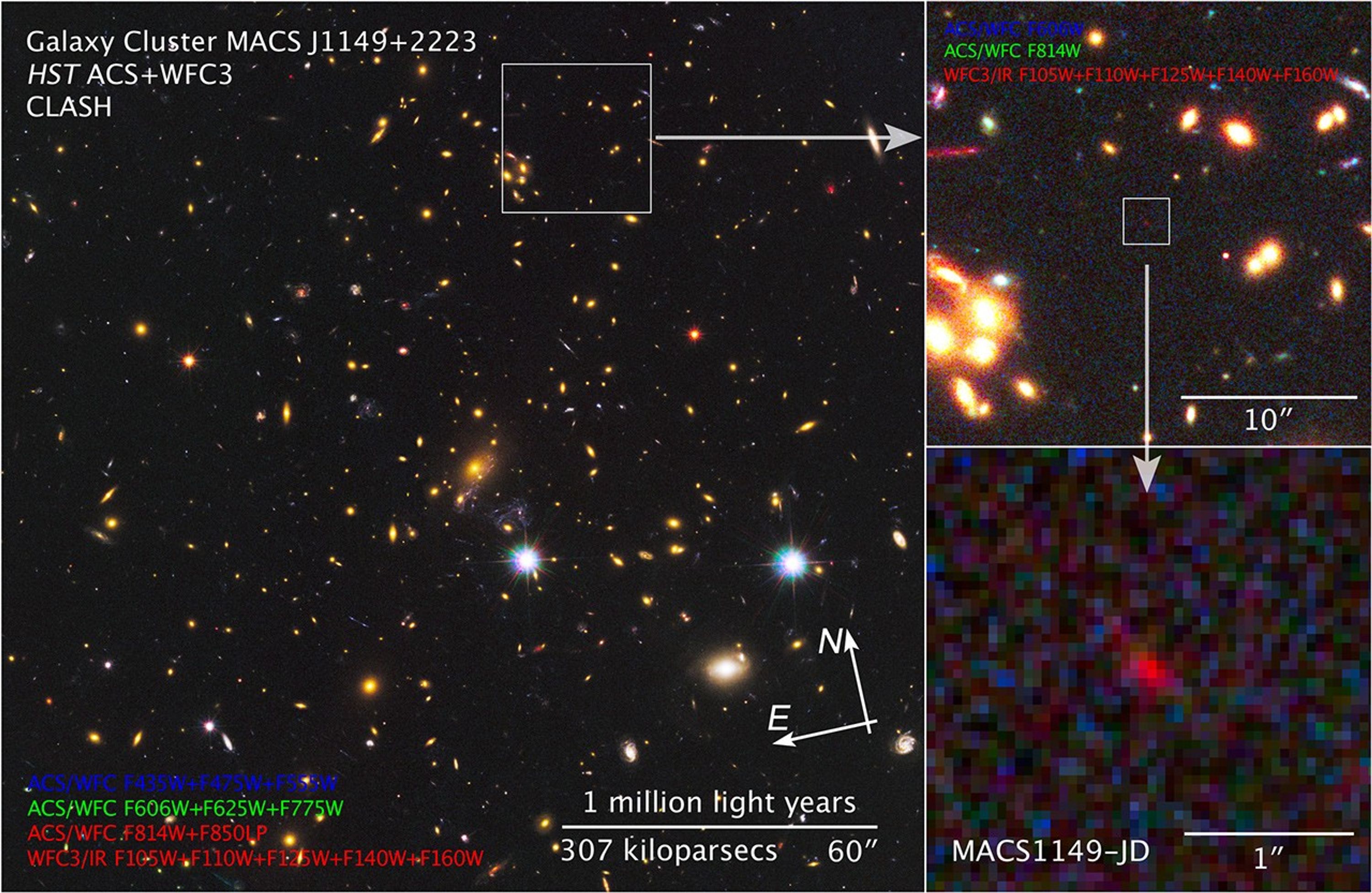1 min read
A Glimmer from a Dark Cosmic Era

With the combined power of NASA's Spitzer and Hubble space telescopes, as well as a cosmic magnification effect, astronomers have spotted what could be the most distant galaxy ever seen. Light from the primordial galaxy traveled approximately 13.2 billion light-years before reaching NASA's telescopes, shining forth from the so-called cosmic dark ages when the universe was just 3.6 percent of its present age.
Astronomers relied on gravitational lensing to catch sight of the early, distant galaxy. In this phenomenon, predicted by Albert Einstein a century ago, the gravity of foreground objects warps and magnifies the light from background objects.
In the big image at left, the many galaxies of a massive cluster called MACS J1149+2223 dominate the scene. Gravitational lensing by the giant cluster brightened the light from the newfound galaxy, known as MACS1149-JD, some 15 times, bringing the remote object into view.
At upper right, a partial zoom-in shows MACS1149-JD in more detail, and a deeper zoom appears to the lower right. In these visible and infrared light images from Hubble, MACS1149- JD looks like a dim, red speck. The small galaxy's starlight has been stretched into longer wavelengths, or "redshifted," by the expansion of the universe. MACS1149-JD's stars originally emitted the infrared light seen here at much shorter, higher-energy wavelengths, such as ultraviolet.
The far-off galaxy existed within an important era when the universe transformed from a starless expanse during the dark ages to a recognizable cosmos full of galaxies. The discovery of the faint, small galaxy opens a window onto the deepest, remotest epochs of cosmic history.
About the Object
- R.A. PositionR.A. PositionRight ascension – analogous to longitude – is one component of an object's position.11h 49m 35.5s
- Dec. PositionDec. PositionDeclination – analogous to latitude – is one component of an object's position.22° 24' 4.21"
- ConstellationConstellationOne of 88 recognized regions of the celestial sphere in which the object appears.Leo
- DistanceDistanceThe physical distance from Earth to the astronomical object. Distances within our solar system are usually measured in Astronomical Units (AU). Distances between stars are usually measured in light-years. Interstellar distances can also be measured in parsecs.The distance to the cluster is 5.3 billion light-years (1.6 billion parsecs or redshift z = 0.544). The distance to the lensed source is 13.2 billion light-years (4 billion parsecs or redshift z = 9.6).
About the Data
- Data DescriptionData DescriptionProposal: A description of the observations, their scientific justification, and the links to the data available in the science archive.
Science Team: The astronomers who planned the observations and analyzed the data. "PI" refers to the Principal Investigator.The image was created from Hubble data from proposals 9722: PI: H. Ebeling (University of Hawaii); and 12068: PI: M. Postman (STScI). - InstrumentInstrumentThe science instrument used to produce the data.HST>ACS/WFC and HST>WFC3/IR
- Exposure DatesExposure DatesThe date(s) that the telescope made its observations and the total exposure time.2004, 2010, and 2011, Exposure Time: 11.3 hours
- FiltersFiltersThe camera filters that were used in the science observations.ACS/WFC F435W (B), F475W (g), F555W (V), F606W (V), F625W (r), F775W (I), F814W (I), and F850LP (z) WFC3/IR F105W (Y), F110W (YJ), F125W (J), F140W (JH), and F160W(H)
- Object NameObject NameA name or catalog number that astronomers use to identify an astronomical object.MACS J1149+2223, MACS1149-JD
- Object DescriptionObject DescriptionThe type of astronomical object.Galaxy Cluster/Gravitational Lens and z=9.6 Galaxy Candidate
- Release DateSeptember 19, 2012
- Science ReleaseNASA Telescopes Spy Ultra-Distant Galaxy Amidst Cosmic ‘Dark Ages’
- Credit

This image is a composite of separate exposures acquired by the ACS and WFC3 instruments. Several filters were used to sample various wavelengths. The color results from assigning different hues (colors) to each monochromatic (grayscale) image associated: Blue: ACS/WFC F435W (B) + F475W (g) + F555W (V) Green: ACS/WFC F606W (V) + F625W (r) + F775W (I) + Red: ACS/WFC F814W (I) + F850LP (z) + WFC3/IR F105W (Y) + F110W (YJ) + F125W (J) + F140W (JH) + F160W(H)

Share
Details
Claire Andreoli
NASA’s Goddard Space Flight Center
Greenbelt, Maryland
claire.andreoli@nasa.gov





































